Farming was one of the hardest hit segments of the New Mexico economy during the Great Depression. In 1931, the state’s most important crops were only worth about half of their 1929 value. Dry farmers were especially devastated as they suffered from both continually high operating costs and a prolonged drought that dried up portions of New Mexico so badly that they became part of the Dust Bowl. From Oklahoma to eastern New Mexico, winds picked up the dry topsoil, forming great clouds of dust so thick that it filled the air. On May 28, 1937, one dust cloud, or “black roller,” measuring fifteen hundred feet high and a mile across, descended upon the farming and ranching community of Clayton, New Mexico. The dust blew for hours and was so thick that electric lights could not be seen across the street. Everywhere they hit, the dust storms killed livestock and destroyed crops. In the Estancia Valley entire crops of pinto beans were killed, and that once productive area was transformed into what author John L. Sinclair has called “the valley of broken hearts.”
In all of New Mexico, farmland dropped in value until it bottomed out at an average of $4.95 an acre, the lowest value per acre of land in the United States. Many New Mexico farmers had few or no crops to sell and eventually, they were forced to sell their land contributing in the process to the overall decline in farmland values.
The Depression also hurt New Mexico’s cattle ranchers, for they suffered from both drought and a shrinking marketplace. As grasslands dried up, they raised fewer cattle; and as the demand for beef declined, so did the value of the cattle on New Mexico’s rangelands. Like the farmers, many ranchers fell behind in their taxes and were forced to sell their land, which was bought by large ranchers.
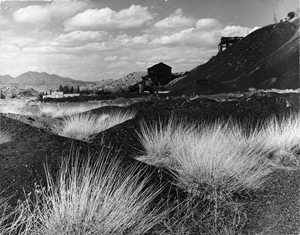 Agriculture’s ailing economic condition had a particularly harsh effect on New Mexico, because the state was still primarily rural during the 1930’s, with most of its people employed in raising crops and livestock. Yet farmers and ranchers were not the only ones to appear on the list of those devastated by depressed economic conditions. Indeed, high on the list were the miners, who watched their industry continue the downward slide that had begun in the 1920’s. Many mines became the property of larger companies when conditions forced many of the smaller companies out of business. The oil industry, however, remained a bright spot in an otherwise bleak economic picture, for increased oil production provided needed tax money to the state. Tourism also received a boost when the federal government released some federal relief money to create new state parks.
Agriculture’s ailing economic condition had a particularly harsh effect on New Mexico, because the state was still primarily rural during the 1930’s, with most of its people employed in raising crops and livestock. Yet farmers and ranchers were not the only ones to appear on the list of those devastated by depressed economic conditions. Indeed, high on the list were the miners, who watched their industry continue the downward slide that had begun in the 1920’s. Many mines became the property of larger companies when conditions forced many of the smaller companies out of business. The oil industry, however, remained a bright spot in an otherwise bleak economic picture, for increased oil production provided needed tax money to the state. Tourism also received a boost when the federal government released some federal relief money to create new state parks.
New Deal Programs and the Beginnings of Public Art
Taking office in March 1933, President Franklin D. Roosevelt’s New Deal relief measures were sent to Congress and within months, most of the acts the president wanted were passed. New Mexicans welcomed New Deal programs of all kinds. Some of the New Deal programs, such as the Works Progress Administration (WPA), put people to work in varying jobs: writers, artists, and musicians practiced their trades as employees of WPA projects, while others who worked for the WPA built schools and other public buildings, including the library and the administration building at the University of New Mexico. By 1936 more than thirteen thousand New Mexicans had found jobs through this program.
The financial hardships of Santa Fe painter Shuster were replicated thousands of times over among artists countrywide. In early 1933 he wrote to his good friend, New York artist John Sloan:
"Dear Sloan,
…I have been able to make all told since I returned from the homestead only $75….The merchants here…are now beginning to feel the pinch and are consequently beginning to pinch the other fellow….I am trying…to meet all my current bills and letting the old ones ride until such time as I get the cash to pay them. Yesterday I had to tell the light company to turn the…electricity off…and that I would use kerosene lamps."
Shuster’s plight was shared by construction workers, clerical personnel, engineers, teachers, merchants – America’s working class – as well. His words admitted the reality of a bleak and frightening future for the U.S. community at large.
For the artist, the collapse of the stock market equated the collapse of the art market: art collectors and patrons, now without stock dividend income that provided the means for the acquisition of ‘luxury’ items, could not purchase art. The romance of the ‘starving artist’ took on urgent and less than romantic connotation – and warning.
In December,1933, Shuster wrote his friend again, but this letter was one of ebullience and optimism: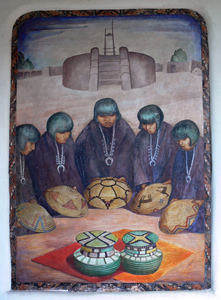 “The most important thing which has happened to the Shuster family is this Federal Art Project. Forty two fifty a week from the Government for painting. My God it doesn’t seem real.” (It is interesting to note that a weekly wage of $42.50 in 1933 was the equivalent of $472.00 per week in 1992.)
“The most important thing which has happened to the Shuster family is this Federal Art Project. Forty two fifty a week from the Government for painting. My God it doesn’t seem real.” (It is interesting to note that a weekly wage of $42.50 in 1933 was the equivalent of $472.00 per week in 1992.)
In the letter Shuster explained his proposal for three projects one of which Shuster ultimately painted pictures of the Carlsbad Caverns, which were acquired by the National Park Service, and presently hang in the Western Archaeological Conference Center in Tucson, Arizona. He was awarded a second Public Works of Art Project (PWAP) project: to paint murals on the wall of the enclosed patio of the Museum of Art, in Santa Fe.
The PWAP was the first federally funded art program under the Civil Works Administration (CWA) – a New Deal work-relief program created by President Roosevelt to alleviate the economic job crisis. In time, all the federal art projects have come to be generically referred to as “WPA Art,” (Works Progress Administration, or WPA).
The CWA was administered by socially conscious Harry Hopkins whose heartfelt belief was that “artists have to eat like other people.” The PWAP started in December 1933 and continued until June 1934, and was the brainchild of artist George Biddle, a former schoolmate of President Roosevelt at Groton and Harvard. An advocate of mural art in America, Biddle had studied with the Mexican muralist, Diego Rivera, and it was his belief that Rivera and others gave voice to the social ideals of the Mexican Revolution of 1910 through their vivid, colorful murals. It would follow, he believed, that murals painted by American artists in the United States would be appropriate vehicles for the expression of the ideals of Roosevelt’s New Deal. Murals painted by Biddle and New Mexico’s Emil Bisttram may be seen today in the Department of Justice Building in Washington DC.
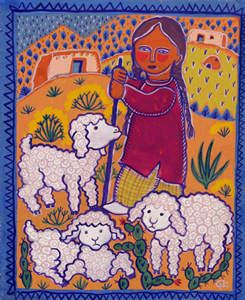 Between 1933 – 1943, in the depth of the Depression, 167 known artists lived in New Mexico, all struggling to sell art in a time when many Americans had little money available even for necessities. The New Deal’s Works Progress Administration Art Project provided an opportunity for artists to create artwork for public buildings, allowing them to remain independent, support their families, and enrich and enhance the community.
Between 1933 – 1943, in the depth of the Depression, 167 known artists lived in New Mexico, all struggling to sell art in a time when many Americans had little money available even for necessities. The New Deal’s Works Progress Administration Art Project provided an opportunity for artists to create artwork for public buildings, allowing them to remain independent, support their families, and enrich and enhance the community.
The following New Mexico artists were among the many employed in WPA projects: Pablita Velarde, Maria Martinez, Ila McAfee, Gerald Cassidy, Will Shuster, Lloyd Moylan, Gisella Loeffler, Eliseo Rodriguez, Kenneth Adams, Fremont F. Ellis and Peter Hurd. The area coordinator of the WPA’s Public Works of Art Project was woodblock printer, painter and marionette-maker Gustave Baumann, a leading member of the Santa Fe art community. More than 65 murals with varied subject materials were created in New Mexico during the Depression. In addition to these murals, the WPA sponsored more than 650 paintings, ten sculptural pieces, and numerous indigenous Hispanic Native American crafts.
Federal Art Project (FAP) and the Hispanic Community
The Works Progress Administration in New Mexico developed a strong relationship with the Hispanic Community through its conscious attempt to maintain a tangible sense of ethnic identity, community cohesiveness, and responsive training throughout their projects. The Federal Art Project (FAP) was directed by New Mexico artist R. Vernon Hunter, who believed in a broad definition of “Art” which included both the fine arts and craft arts. Hunter was dedicated to his task and encouraged his associates in all media to imbue their work with individuality and spirit.
The FAP in New Mexico promoted, initiated, and supervised all relief art activities in the state. In addition to commissioning easel work, prints, sculpture, and murals in fresco and oil for public buildings, the FAP supported programs for reviving craftwork of Spanish-Colonial origin (woodworking, embroidery, weaving, and metalwork), teaching of arts and crafts in community art centers, researching native arts for the Index of American Design (IAD), and compiling a project unique to New Mexico, the Portfolio of Spanish-Colonial Design. In particular, Hunter wished to maintain traditional art forms which were in danger of extinction from pressures for wage labor jobs in a non-Hispanic dominated culture.
Clearly Hunter viewed his program as providing more than just crucial financial reward to the artists. For him, the national exposure that he consistently sought for artists was a method of raising ethnic respect both within the state’s Hispanic communities and throughout the nation. He was sensitive to the importance of maintaining communal traditions as a way to establish a context for individuality, and he understood self-worth as a direct factor in pride of ethnic identity.
Acknowledgments
Federal Support for Hispanic Art
“Treasures on New Mexico Trails,” Chap.4
Andrew Connors
The Indian New Deal In New Mexico
President Roosevelt appointed John Collier as Commissioner of Indian Affairs (1933 – 1945). Collier took full advantage of New Deal funds to promote Indian arts and crafts, increase employment, improve infrastructure on reservations, and construct schools. Collier was an idealist who struggled to reform federal Indian policy during his twelve-year term. Years earlier, during a 1920 visit to his close friend, Taos resident and art patron Mabel Dodge Luhan, he had embraced Pueblo Indian culture as offering nothing less than salvation from the ills of Western Civilization.
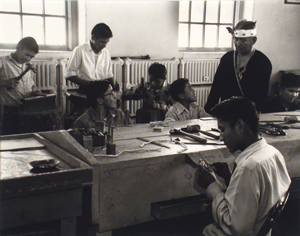 The headquarters of the Indian Division was at Santa Fe Indian School, where the artists took room and board. Superintendent Chester E. Faris endeavored to hire Indian artists and craftsmen and promote Indian arts as a profession that would permit students to continue living at home if they desired. The students worked under the direction of painting teacher Dorothy Dunn and crafts teacher Mabel Morrow. The artists included Pablita Velarde (Santa Clara) and Andy Tsinajinnie (Navajo), both about 16 years old at the time. They worked with established artists Velino Shije Herrera (Zia), Tonita Pena (San Ildefonso), Emiliano Abeyta (San Juan), Tony Archuleta (Taos), Jack Hokeah (Kiowa), and Calvin Tyndall (Omaha).
The headquarters of the Indian Division was at Santa Fe Indian School, where the artists took room and board. Superintendent Chester E. Faris endeavored to hire Indian artists and craftsmen and promote Indian arts as a profession that would permit students to continue living at home if they desired. The students worked under the direction of painting teacher Dorothy Dunn and crafts teacher Mabel Morrow. The artists included Pablita Velarde (Santa Clara) and Andy Tsinajinnie (Navajo), both about 16 years old at the time. They worked with established artists Velino Shije Herrera (Zia), Tonita Pena (San Ildefonso), Emiliano Abeyta (San Juan), Tony Archuleta (Taos), Jack Hokeah (Kiowa), and Calvin Tyndall (Omaha).
Velarde recalled that at SFIS (Santa Fe Indian School), Tonita Pena became her mentor. “Tonita was really a help to me in my early years at the Indian school…..She was staying at the girls’ dorm. That’s how we got acquainted. She talked Tewa, and she used to tease and laugh and joke in Indian, and that was fun. Then she would be sitting in her room in the evening, just painting for herself, and I’d watch her and talk to her.” These conversations convinced Velarde that she could overcome the difficulties of being both a Pueblo woman and an artist.
Six Navajo weavers came to the school, bringing their own wool and yarn. The school furnished additional wool, yarn, and dyes and paid each weaver a salary of $14.85 per person per week plus room and board. The weavers completed 12 rugs ranging in size from 3 ft. by 4 ft. to 4 ft. by 5 ft. 5 in. The weavers were Nellie Cowboy, Mrs. John Jim, Elizabeth Pablo, Mary Phillips, Sallie Kinlichini, and Bah Smith.
The Indian participants in the Public Works of Art Project included the leading Indian painters, potters, and sculptors of the century who created work of significant artistic and historical value under the federal sponsorship. PWAP helped establish Santa Fe as a center of Indian art patronage and Santa Fe Indian School as an institution that fostered both traditional and innovative arts.
As Franklin Roosevelt and the government were dealing with an ailing economy on one front, they were being pulled into fighting a world war on the other.
Acknowledgments
Treasures on New Mexico Trails:
Discovery of New Deal Art and Architecture
Kathryn A. Flynn and Andrew L. Connors
Sunstone Press, Santa Fe, 1994
New Mexico, Revised Edition
Calvin & Susan Roberts
University of New Mexico Press, Albuquerque, 2006
The Collector’s Guide
www.collectorsguide.com/fa/fa068.shtml
World War II and The Bataan Death March
Japan’s aerial assault on the U.S. Pacific Fleet at Pearl Harbor, Hawaii, on December 7, 1941, brought the United States into World War II. After the U.S. declaration of war on Japan, the following day Germany and Italy declared war on the United States. The US thus joined Britain, the Soviet Union, and other nations in the Allied Powers arrayed against Germany, Italy and Japan.
Among the first Americans to see action in World War II were New Mexico National Guardsmen, who were fighting in the Pacific even before the formal declaration of war. They were members of the National Guard 111th Cavalry, which became part of the 200th Coast Artillery, Anti-Aircraft Regiment in 1940. Deployed in September 1941 to the Philippines, then a U.S. possession, the troops of the 200th were assigned the task of defending Clark Field and Fort Stotsenberg, which lay seventy-five miles north of the Philippine capital of Manila. Hundreds of New Mexicans were at Clark Field when the Japanese attacked just ten hours after the strike on Pearl Harbor. For the most part, the New Mexicans found their job frustrating because their anti-aircraft shells could not hit high-flying Japanese bombers, although the men of the 200th did shoot down some low-flying Japanese fighter planes.
When the Japanese ground forces launched their major assault on the Philippines, New Mexicans fought as members of two regiments – the original 200th and the newly created 515th Coast Artillery Regiment. These regiments heroically covered the withdrawal of American and Filipino troops to the Bataan Peninsula and held on until April 9, 1942 when they surrendered. What followed has come to be known as the Bataan Death March, a sixty-five-mile forced march of American prisoners to trains waiting to carry them to a Japanese prison camp. The march took six days, and eleven thousand Americans, including many New Mexicans, died on the way. Those who reached the camps and survived the terrible conditions there remained prisoners of war until 1945, witnessing during their captivity the deaths of thousands of their less fortunate comrades, again including many New Mexicans. Among the eighteen hundred New Mexicans serving in the Philippines, only nine hundred returned home.
The Hispanic contributions made in World War II for America were overwhelming. The historically rich 200th Coastal Artillery was sent to the Philippines in September 1941; the 200th was born from the New Mexican Cavalry that was dispatched to Cuba to fight with Teddy Roosevelt’s “Rough Riders” in the Spanish-American War. When New Mexico became a state in 1912 several decades later, the Cavalry was federalized and the 200th became one of the most ethnically diverse National Guard battalions in the United States.
The tenacity of the 200th gave the US military time to re-fortify and plan for the European front, possibly changing the course of the war. These brave soldiers were responsible for the defense of the islands of Luzon, Corregidor and the harbor defense forts of the Philippines.
The Army ROTC Department at New Mexico State University began sponsoring the Bataan Memorial March in 1989 honor New Mexico’s 200th and 515th Coast Artilleries, the most decorated units of World War II. The annual Bataan Memorial March is held each year at White Sands Missile Range with marchers from across the United States and several foreign countries taking part in the military event.
In addition, a former state building in Santa Fe was renamed the Bataan Memorial Building. Outside the building, an eternal flame burns for those New Mexicans who did not survive the march or the Japanese POW camps.
Acknowledgments
New Mexico, Revised Edition
Calvin & Susan Roberts
University of New Mexico Press, Albuquerque, 2006
Monsters and Critics
www.monstersandcritics.com/people/features/article_1310412.php/Bataan_death_march.html%22
The Navajo Code Talkers
World War II lasted nearly four years. During that time over 50,000 New Mexicans served in the armed forces. They saw action against not only Japan, but also Germany and Italy. One group from New Mexico and Arizona played a special role. These were the Navajo Code Talkers. The Marine Corps needed a way to send messages quickly by radio. They used Navajo Marines to do this.
In the early days after Pearl Harbor, Corregidor, and a series of naval disasters, not only did the Japanese have superior arms, position, and equipment, they were breaking our tightest communication codes with disastrous results for the American Armed forces.
By the time Carl Gorman Sr., the father of the Taos artist R.C. Gorman, New Mexico had reached the Marine recruiting station at Fort Defiance, a plan had already been developed that would involve him personally in one of the most important secret operations in American military history. It was to be the creation of a military code for combat and invasion purposes that the enemy would never break. The men destined for the assignment were Navajos.
Ironically, it was a white man who presented the idea for this invulnerable code. He was Philip Johnston, an American engineer who had grown up on the Navajo reservation, a missionary’s son, learning to speak Navajo fluently as a child. He proposed his idea to the Marine top brass at Camp Elliott in California. At first they thought he was insane. No cryptography, no code machines. Only a Navajo sender at one end and a Navajo receiver at the other, who translated the message into English, and it worked!
The Japanese were already on Guadalcanal in the summer of 1942, breaking all the American codes. From Marine headquarters, a guarded authorization went out for a pilot test group of thirty Navajos to develop the new code. Recruits had to be found at once who spoke Navajo and English well. The recruits came from the reservation boarding schools and from far-away hogans, too. Most had never gone more than a few miles from their native homes, and some were so young they forged their age to enlist. All were inducted at Fort Wingate, New Mexico. They had no knowledge as yet of the true nature of their mission. All they were told was that they were in special service. There were twenty-nine including Carl Gorman taken by train through the night to Camp Elliott in California.
A whole assortment of military words had to be invented for translation into Navajo. It became an exciting game, as they went on to search for the appropriate word. Airplanes became “birds”. A bomber was a “buzzard”; a fighter plane, “a hummingbird”; a patrol plane a “crow”.
The Navajo recruits were required to memorize the hundreds of words and phrases, most of them foreign to their own basic culture. Gorman explained the speed with which the Navajo boys were learning. "You have to understand that for us, everything is memory. You see it’s part of our heritage. We have no written language. Our songs, our prayers, our stories, they’re all handed down from grandfather to father to children—and we listen, we hear, we learn to remember everything. It is part of our training."
The Japanese never broke the code. Many marines owed their lives to the speedy messages sent in Navajo. It was many years after the end of WWII before the Navajo Code Talkers were recognized for their contribution to the war effort. This happened because of the value that the code still had.
The Navajo Code Talkers were also used in Korea in the 1950’s and in Vietnam in the 1960’s. This is how secure this code was. It still was not broken during these wars. It also shows how much confidence that the military had in this system of coding. The code was finally declassified in 1968 as electronic equipment was developed.
Acknowledgments
New Mexico, Revised Edition
Calvin & Susan Roberts
University of New Mexico Press, Albuquerque, 2006
Our New Mexico
Calvin A. Roberts, Ph.D.
University of New Mexico Press, Albuquerque, 2006
The Manhattan Project
At 5:29:45 a.m., Mountain War Time on July 16, 1945, the world’s first atomic bomb exploded one hundred feet over the portion of the Southern New Mexico desert known as the Jornada del Muerta – the Journey of the Dead Man. On seeing the fireball and mushroom cloud, J. Robert Oppenheimer, Scientific Director of the Manhattan Project, recalled a passage from the Bhagavad-Gita, “I am become death the destroyer of worlds.”
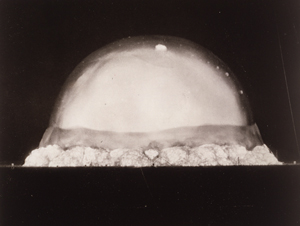 The light that shattered the early morning darkness of the Tularosa Basin at 5:30 a.m., put New Mexico’s smallest county on the map of the world. Los Alamos (which means “the poplars”) sits on a high, gently sloping plateau. It was there that the secret atomic city for the Manhattan Project was built. From 1943 – 1945, the tiny community of Los Alamos, New Mexico, formed an unreal world, part mountain resort and part military base.
The light that shattered the early morning darkness of the Tularosa Basin at 5:30 a.m., put New Mexico’s smallest county on the map of the world. Los Alamos (which means “the poplars”) sits on a high, gently sloping plateau. It was there that the secret atomic city for the Manhattan Project was built. From 1943 – 1945, the tiny community of Los Alamos, New Mexico, formed an unreal world, part mountain resort and part military base.
The federal government used its powers of eminent domain to take over many Hispanic homesteads for the Manhattan Project in 1942. Many owners received payment but some received nothing because they failed to make the 85-mile trek to the Sandoval County Courthouse each year to pay their property taxes. Moving swiftly the government also took over the exclusive Los Alamos Ranch School for Boys, and the lands of about twenty-six other area inhabitants. Much was already government owned and soon totaled about 9,000 acres.
In the beginning Los Alamos Laboratory, known as Project Y, was conceived during the early part of World War II. The United States wanted to build an atomic explosive to counter the threat posed by the German nuclear development program. The term Manhattan Project came about because the program began under the Manhattan Engineering District of the War Department.
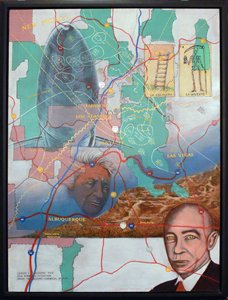 General Leslie Groves, military head of the project, and Robert Oppenheimer, scientific director, wanted the top secret project to take place in an isolated area yet still be accessible, a place with an adequate water supply, a readily available labor source, and a moderate climate. Oppenheimer assumed that facilities would be needed to house perhaps thirty scientists and their families. The “realists” of the time argued that they would need room for at least 500. At the end of the war, close to 6,000 people were living on the Hill and Los Alamos was born.
General Leslie Groves, military head of the project, and Robert Oppenheimer, scientific director, wanted the top secret project to take place in an isolated area yet still be accessible, a place with an adequate water supply, a readily available labor source, and a moderate climate. Oppenheimer assumed that facilities would be needed to house perhaps thirty scientists and their families. The “realists” of the time argued that they would need room for at least 500. At the end of the war, close to 6,000 people were living on the Hill and Los Alamos was born.
Oppenheimer recruited many of the top personnel himself. His job was made easier by the fact that the scientists knew they would be applying their talents for the benefit of their country. They also knew that if they succeeded, they would become a part of history..
For ordinary civilians, military security took some getting used to. Laboratory members were not allowed personal contact with relatives or permitted to travel more than 100 miles from Los Alamos. Security personnel censored outgoing mail and monitored long-distance calls. Incoming mail was addressed simply to “P.O. Box 1663, Santa Fe, New Mexico.” Birth certificates of infants born at Los Alamos during the war even listed P.O. Box 1663 as their place of birth.
The homogeneity of the community led to some interesting problems. Because so many scientist brought spouses and young children to the site, the need for a school ranked in importance with the need for a new physics laboratory. The relative youth of the inhabitants also led to a baby boom. In the first year of the project, 80 babies were born; by 1945 Los Alamos had more than 330 infants.
The successful nuclear test at Trinity Site and the subsequent use of nuclear weapons at Hiroshima and Nagasaki had a long-term effect on both the U.S. and Japan. The test at Trinity Site signaled the entrance of New Mexico into a new era and marked the integration of the oldest settled portion of the United States with industrial and urban America, for the growth of industry and cities in New Mexico really began during World War II. Thanks to the defense industry and related enterprises, New Mexico is now a far cry from 1933 when the largest city had a population of less than 35,000 and when fewer than 3,000 people were employed in factories.
Acknowledgments
New Mexico Past and Present – A Historical Reader
Richard N. Ellis,
University of New Mexico Press, Albuquerque, 1971
Los Alamos Historical Society
http://www.losalamoshistory.org/manhattan.htm
http://www.losalamoshistory.org/oppiehouse.htm
